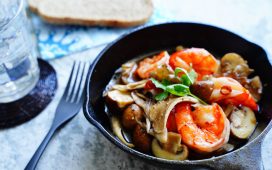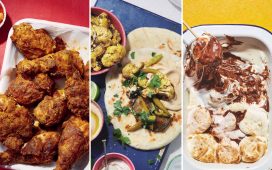When I heard the name Floyd Cardoz, my mind always went straight to watermelon curry.
Yours probably did, too, if you went to Tabla, the restaurant off Madison Square Park where he was the chef (and an owner, with Danny Meyer) from its opening in 1998 until the end of 2010. Of all the dishes he served there, the watermelon curry was the one everybody talked about, almost always with some mix of pleasure, admiration and wonder.
It was a sauce for halibut and, like many great recipes, it was simple. The curry started with fresh ginger and garlic, of course, along with a truly minimal number of spices: coriander, cumin, Aleppo pepper and a whiff of dried turmeric. The kitchen stirred this in hot oil and then cooked it with puréed watermelon. The simplicity was a good part of the joy of eating it. You could, without much trouble, pick out all the flavors and still be surprised by what they did together.
And watermelon! How could watermelon juice be a major ingredient of an expensive main course at a serious restaurant? Because Floyd Cardoz said so, and that was that.
Mr. Cardoz, who died on Tuesday of the coronavirus, made challenging things look easy. Most impressively, he built his own kitchen language from elements of his childhood and early professional training in India; his labor in precise, demanding Swiss kitchens; the lessons in juxtaposing ideas from different cuisines that he imbibed under Gray Kunz at Lespinasse; and his life as an immigrant who survived and ultimately thrived in New York City.
You could hear this distinctive language, a language that anyone could learn but that belonged only to Mr. Cardoz, when you ate at Tabla and its smaller and less expensive downstairs sibling, Bread Bar. After they closed and Mr. Cardoz moved on to other kitchens, you could pick it up again at the North End Grill, Paowalla and Bombay Bread Bar. No doubt you could hear it, with different accents, at the restaurants he opened in India.
He told us stories about the thrills and the comforts of India. This was the explicit subject of the menus at Paowalla, in SoHo, and its slightly zippier successor, Bombay Bread Bar.
He told us that sharing your enthusiasms could be a form of generosity. From most points of view, it doesn’t make a lot of sense for one restaurant to serve about a dozen egg dishes, unless it’s a diner. It makes even less sense for that same restaurant to offer every single-malt Scotch of every known region, shade, aroma, flavor, style and age. Mr. Cardoz was wild about eggs, though, and crazy for Scotch, so at North End Grill he bet heavily on both.
He told us about what happens to a culture that is carried to the United States, too, how it could be honored even as it was bent nearly beyond recognition.
New York had seen fancy, expensive Indian restaurants before Tabla and Bread Bar. But the cooking at most of them seemed featureless, generic, next to Mr. Cardoz’s flights of creativity. Some of the little snacks I had at Bread Bar, things that would have been forgettable filler on anybody else’s menu, have stayed with me for years: the naan with needles of rosemary baked into the dough, the popcorn tossed with hot ghee and chat masala, the sandwich of pulled lamb and soft potatoes turned an intense yellow by mustard seeds.
You could have all three of these things in the same meal at Bread Bar while you clutched a wildly refreshing highball called a Kachumber Cooler, which is one reason I ate there more often than I did at Tabla.
Each time, I’d look up at the people sitting at the tables arranged around the circular opening in Tabla’s floor (or Bread Bar’s ceiling, depending on where you sat) and hope that somebody was eating the halibut with watermelon curry.






